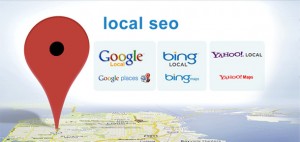Best Practices in Local Search Engine Optimization
The big three, Google, Bing, and Yahoo!, are putting massive amounts of emphasis on how local search engine results are displayed. You might have already noticed local listing information blending in with organic results. We here at Optimize Worldwide encourage local businesses to claim your business listings and verify the accuracy, as well as the consistency, of your business information. We will go into details about optimizing your local business listings in an upcoming article. Today we will shed some light on how to optimize your local business website with a few web development optimization tips.
 Build a Local Landing Page for Each Location
Build a Local Landing Page for Each Location
Many local businesses I’ve worked with wish to rank for multiple city + service oriented terms for each of their locations, but only a few realize that each location deserves its very own landing page.
In a way, it’s like asking to get business from all over your business service area, without actually having brick and mortar locations to service local customers. In this case, Google is your customer, and it needs to see a separate ‘landing page’ for each of your locations to be a satisfied ‘customer’.
Local Landing Pages for Each Location = Good Local Search Engine Rankings
In fact, having a local landing page for each business location or area served will not only enhance your your organic rankings, it’ll most likely be a cited website picked up by Google Maps as well. Talk about killing two birds with one stone.
Local Landing Page Best Practices
What’s useful for people to find your location faster, is useful for the search engines as well. Here’s our top 10 factors to include in a local landing page, starting from the top to the bottom of the page.
If the tips below are outside of your expertise or know how, we can help you implement local search engine optimization across your websites, just shoot us an email seo@optimizeworldwide.com
- Optimized Title Tags – Business Name + Service Type, City, Province/State | Keyword 1 & Keyword 2. Ex: “Joe’s Bakery, Redding, CA | The Best Wedding Cakes and Twinkies in Redding”.
- H1 & H2 Tags – Use header tags that reflect your full business name and service type. Ex: “Joe’s Bakery, Redding, California”.
- Full Business Address – Include this in a easy to use hCard microformat. hCard may help the search engines separate address information such as business name, street address, locality, and postal/zip codes. Interested in how to create an address in hcard? Try the handy hCard generator.
- Regional/Local Phone Number – Local phone numbers build trust – both from customers, and from search engines. Often, businesses such as plumbers only have one service location, but multiple local phone numbers to gain trust from small town customers, which they then forward to a singular call center. ALWAYS use a local phone number on each landing page in the format (530) 555-5555.
- Services Offered & Business Hours – Services often differ from location to location based as do business hours. Save your customers time and add to your body content by adding this valuable information.
- Embed Google Maps on your Landing Page – This is imperative to include on your landing page. Not only will it provide an interactive way for a customer to map their way to your location, it will also count towards a better ranking in the Google local ten-pack listings.
- Include Driving Directions Anyways – Unless your customers are relatively savvy with the concept of using Google Maps to get driving directions to your location, you’re best off by providing a brief paragraph of directions from the NSEW (North, South, East, West) end of your city.
- Single Line Business Address in Footer– Having your address in the format ‘Business Name + Service, Street Address, City, Province/State, Country’ can provide an easy format for search engines to pick up on your address.
- Meta Tag Descriptions with Local Address + Phone Number – This one’s self-explanatory. If you’ve got an additional phone tracking number handy, you can include the spare phone number in your meta tags to see if customers would rather call you via seeing the search results, or prefer to click on the results and view your landing page. This tactic is also specially useful for folks that use Skype (which makes phone numbers clickable) and on the iPhone.
- URL Naming Structure – Last but not least, it’s important to include keywords in your URL. Separate keywords by using hyphen’s and only include your most important keywords minus your business name, unless you have a highly recognized brand: Ex: domain.com/redding-rexdale-california-bakery.html
We promise you that if you’re diligent in your landing page design and follow the tips above, you’ll score some neat rankings in non-competitive markets. Subscribe to our RSS feed today to keep updated on a future post on how to capture local rankings for competitive search terms. And don’t hesitate to call us, Optimize Worldwide (530) 710-8283, if you need help ranking in the local search engine results for you local business.

 Build a Local Landing Page for Each Location
Build a Local Landing Page for Each Location